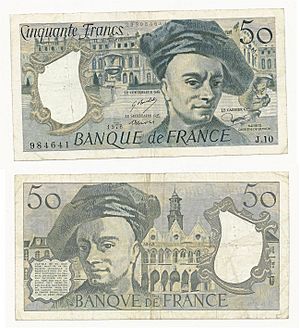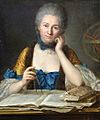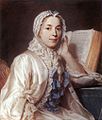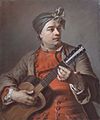Maurice Quentin de La Tour facts for kids
Quick facts for kids
Maurice Quentin de La Tour
|
|
|---|---|
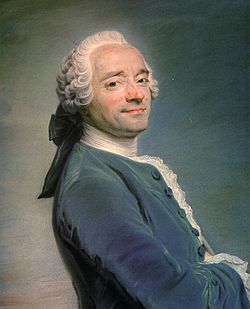
Self-portrait with Lace Jabot (around 1751)
|
|
| Born |
Maurice-Quentin Delatour
5 September 1704 |
| Died | 17 February 1788 (aged 83) |
| Nationality | French |
| Known for | Pastel |
Maurice Quentin de La Tour (born September 5, 1704 – died February 17, 1788) was a French artist. He was known for painting portraits in the Rococo style. He mostly used pastels, which are like colored chalks. Some of the famous people he painted include Voltaire, Rousseau, King Louis XV, and Madame de Pompadour.
Contents
The Life of Maurice Quentin de La Tour
Maurice Quentin de La Tour was born in Saint-Quentin, Aisne, France. He was the third son of François de La Tour, who was a musician. His father was a trumpet player and musician for a church. People often say his father didn't want him to become an artist, but there's no real proof of this.
Early Life and Art Training
When Maurice was about 15, he started learning to paint. He moved to Paris when he was almost 19 years old. At that time, he already called himself a painter. He briefly visited England in 1725. Then, he came back to Paris in 1727. There, he was encouraged to start painting portraits using pastels. One of his first known portraits was of the famous writer Voltaire.
Becoming a Famous Portrait Artist
In 1737, Maurice de La Tour showed his paintings at the Paris Salon. This was a very important art exhibition. He displayed portraits of Madame Boucher and a Self-Portrait, Laughing. This self-portrait was the first of many he would show over the next 36 years.
On May 25, 1737, he was officially recognized by the Royal Academy of Painting and Sculpture. Soon, he became very popular with the French royal family. He even had an apartment in the Palais du Louvre, a famous palace. By the late 1760s, he stopped painting portraits of the royal family.
People thought de La Tour made his subjects look charming and smart. His gentle but sure way of using pastels made their faces look soft and pleasing.
His Personality and Later Years
People who knew de La Tour said he was lively, good-humored, but also a bit unusual. In many of his self-portraits, he shows himself smiling. He was known for being very nervous, which later led to mental illness. Sometimes, he would work too much on his paintings, even spoiling them.
As he earned more money from his art, he became very generous. He started a drawing school in his hometown of Saint-Quentin. He also gave money to women in need and to older artists and craftspeople. He helped the Royal Academy of Painting and Sculpture in Paris.
Eventually, because of his mental health, he had to stay at home. His brother, Jean-François, took care of him. At age 80, he retired to Saint-Quentin. He passed away there at 83 years old.
Commemoration
Maurice Quentin de La Tour's portrait was featured on French 50 franc banknotes. These banknotes were used from 1976 to 1992.
Images for kids
-
Isabelle de Charrière (1766) -
Prince Henry Benedict Stuart
See also
 In Spanish: Maurice Quentin de La Tour para niños
In Spanish: Maurice Quentin de La Tour para niños


